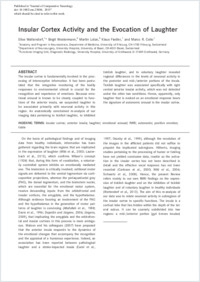Insular cortex activity and the evocation of laughter
- Wattendorf, Elise Anatomy and Program in Neuroscience, Department of Medicine, University of Fribourg, Switzerland
- Westermann, Birgit Department of Neurosurgery, University Hospital, University of Basel, Switzerland
- Lotze, Martin Functional Imaging Unit, Diagnostic Radiology, University Hospital, University of Greifswald, Germany
- Fiedler, Klaus Anatomy and Program in Neuroscience, Department of Medicine, University of Fribourg, Switzerland
- Celio, Marco R. Anatomy and Program in Neuroscience, Department of Medicine, University of Fribourg, Switzerland
-
01.09.2015
Published in:
- Journal of Comparative Neurology. - 2016, vol. 524, no. 8, p. 1608-1615
English
The insular cortex is fundamentally involved in the processing of interoceptive information. It has been postulated that the integrative monitoring of the bodily responses to environmental stimuli is crucial for the recognition and experience of emotions. Because emotional arousal is known to be closely coupled to functions of the anterior insula, we suspected laughter to be associated primarily with neuronal activity in this region. An anatomically constrained re-analysis of our imaging data pertaining to ticklish laughter, to inhibited ticklish laughter, and to voluntary laughter revealed regional differences in the levels of neuronal activity in the posterior and mid-/anterior portions of the insula. Ticklish laughter was associated specifically with right ventral anterior insular activity, which was not detected under the other two conditions. Hence, apparently, only laughter that is evoked as an emotional response bears the signature of autonomic arousal in the insular cortex.
- Faculty
- Faculté des sciences et de médecine
- Department
- Département de Médecine
- Language
-
- English
- Classification
- Biological sciences
- License
- License undefined
- Identifiers
-
- RERO DOC 257255
- DOI 10.1002/cne.23884
- Persistent URL
- https://folia.unifr.ch/unifr/documents/304512
Statistics
Document views: 47
File downloads:
- cel_ica.pdf: 303
